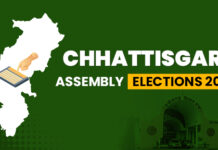It was a chilly January morning in Delhi when I visited BJP’s state unit office exactly three years ago in 2017. It was around 9.00 a.m. and the office was still locked. Hardly a month had passed when Manoj Tiwari was appointed as Delhi BJP chief. The state unit office seemed disoriented with only a couple of empty red chairs in the lawn. AAP was struggling with the office of profit case as Delhi HC had set aside the appointment of 21 MLA’s in September 2016. This ruling had instilled fresh energy in BJP cadre and they were expecting some sort of coup sooner or later.
I had an appointment with a senior BJP functionary who had worked for years with anti-corruption movement and had been instrumental in convincing Anna Hazare to lead India Against Corruption launched by Arvind Kejriwal. He had joined BJP after a sense of deep disillusionment and betrayal in AAP. He came late, greeted, apologised and seemed afresh with some new plans as he opened his advocate’s briefcase and started discussing legal cases against AAP. That was the first instance I chanced upon a phrase “Operation Lotusbloom”. We heard this much later during Gujarat elections when Prime Minister Narendra Modi talked of it at a Kuchh rally.
Today when this five-year AAP-BJP turf-war has culminated in poll campaign, it needs to be told that “Operation Lotusbloom” was meticulously planned to ouster AAP government from Delhi way back in 2016. It is still very much in place. The tactics has changed and strategies re-worked upon.
It all started with a PIL filed by NGO Rashtriya Mukti Morcha against the appointment of 21 AAP MLAs as parliamentary secretaries and turned into a political battle with a defamation case filed by then Union Minister Arun Jaitley against Delhi CM Arvind Kejriwal for which Kejriwal hired senior lawyer Ram Jethmalani. The Ram Jethmalani episode of mid-2017 is still a mystery for many. Did he back off or Kejriwal removed him? Was the issue related to his professional fee that runs into crores? Why did Jethmalani drop a letter bomb on Kejriwal and copied it to Jaitley? Was Kejriwal taken into some sort of trap by Jethmalani? Did Kejriwal chose Jethmalani to kill two birds with one stone and eventually failed? Does this episode relate to the happenings a couple of years later in AAP?
Office of Profit case
The Delhi HC in a petition hearing by Rashtriya Mukti Morcha that sought scrapping of appointments for being “unconstitutional, illegal and without jurisdiction” said in September 2016:
“The specific plea of the petitioner [NGO] that the impugned order dated March 13, 2015, was passed without communicating the decision to the Lieutenant Governor for his views/concurrence has not been disputed by the Respondents (Delhi government). Therefore, we find force in the submission of the petitioner that the issue is squarely covered by the decision [of the HC passed on August 4]…Accordingly, without going into the other contentions raised in the writ petition, the impugned order dated March 13, 2015 is hereby set aside.”
Things went very far in a matter of 15 months. On the recommendation of EC, the President approved the disqualification of AAP MLAs. Delhi government again challenged this in HC. Public opinion was sharply divided on this issue but no one asked a crucial question related to the original petition by Rashtriya Mukti Morcha (RMM) and the decision of AAP/Delhi government in this respect to challenging it on the very face of it.
This becomes important considering that RMM, the NGO was founded by the same Ram Jethmalani who was hired by Kejriwal to represent him against Arun Jaitley in the defamation case. It is an entirely different fact that Jethmalani had parted from this NGO as its founder president way back in 1989 but a look at the history of cases fought by this NGO reveals its political character and affiliations.
Without going into details, just a cursory look at an interview of advocate Ravinder Kumar, the National President of RMM published in Livemint on April 30, 2007, is very insightful in understanding the ideological connections of AAP and RMM. Apart from Sonia Gandhi’s foreign origin case and the Prime Minister of India P.V Narasimha Rao (in Jharkhand Mukti Morcha bribing case in which RMM was responsible for his first conviction) the cases taken up by RMM clearly shows who was getting benefitted politically.
Although Kumar openly pronounced his equal disgust for Congress and BJP, in the interview he says, “All of them are equally hypocritical and live off each other. Both the Congress and the BJP get a chance to rule by turns because of negative voting against the party in power. This indicates how the disgusted and frustrated voters are always seeking a change”. This was the basic premise upon which the AAP party had started its political journey and held itself as an alternative to the BJP-Congress diarchy.
There may be a dozen questions on Arvind Kejriwal in this regard. Let us keep “Operation Lotusbloom” aside for a moment. How come a like-minded and anti-Congress anti-BJP outfit petition against his MLA’s? Why did he choose the founder President of RMM as his lawyer? Why he did not dispute the “specific plea of the petitioner (NGO)”, as mentioned in the HC order? Kejriwal repeatedly alleged the central government and LG of Delhi for not letting his mandated government work smoothly. Why did he not take the name of RMM, the original petitioner in the office of profit case even once? Was this some sort of marriage of convenience? What about his colleagues?
Mandate “fixed” again?
Getting a huge mandate is second to holding it. Once you get a mandate to rule, you need to create and stick on to a perceptional vote. AAP has lost this perception war against its rivals, be it BJP or Congress. The main reason behind this is the centrality of the internal power structure that lies with Arvind Kejriwal much like PM Modi who has unleased the Gujarat model of governance in Centre where the cabinet and ranks become redundant. In Kejriwal’s case, one can call it the Delhi model of governance.
This analogy would have been apter had AAP consolidated its organisational capacity and structure in the last couple of years. But it failed to do as seen by the results of Punjab and Goa.
I am reminded of two insightful articles- one by Yogendra Yadav and the other by Jawed Naqvi. In April 2017, Yadav had written a piece in a national daily where he said, “BJP is out to murder the Aam Aadmi Party but the Arvind Kejriwal-led party will suicide before it gets murdered”. Around the same time Naqvi in his Dawn column titled “The anomalous rise of Mr. Kejriwal” had concluded, “…in Kejriwal’s case when he loses, he wins”. Formulating the “anomalous”, he wrote, “The anomalous rise of Kejriwal persists with its perverse logic”.
This is where questions are raised upon the 2015 Delhi mandate being “fixed” and another upcoming “fixture” on February 11, 2020. In a nation of short term memory loss, it would be useful to remind of a slogan that appeared mysteriously on the website of Aam Aadmi Party in November 2014: ‘Delhi Speaks: Modi for PM, Arvind for CM‘.
The party later removed the image from the homepage of its website, but hundreds of messages on Twitter and Facebook ridiculing the party for its clear endorsement of Prime Minister showed that the damage was done. India Today had reported:
“AAP shamelessly using Namo’s picture on its website as a crutch to sell itself. Sad really,” said a tweet. “Aaj ‘Hail Modi’ & before Gen Elections it was ‘Jail Modi'”, said another. “I’m willing to bet almost anything that #AAP will claim its website was hacked,” a third tweet said. There was no reaction from the party on Twitter, where chief Arvind Kejriwal is pretty active. The AAP even had a statement on the site, which was also removed along with the image.
The statement said, “The voters in Delhi have decided. They want a strong Prime Minister which is why they elected Narendra Modi. They now want a strong Chief Minister so that issues like corruption, inflation, better schools, transport, and hospitals could be resolved. They want Arvind Kejriwal again.” Even a video showing Kejriwal taking oath as Delhi’s chief minister in December last year was removed by the party from its website.
Around February 2015 just before Delhi Assembly elections in last-leg, this slogan became the unofficial campaigning line of AAP when Modi was scheduled to address BJP rallies. The Telegraph had reported then:
The plan has been prompted by fears that Narendra Modi could halt the momentum AAP leaders believe Kejriwal has been able to generate so far and turn the tide in favour of the BJP. To counter such a possibility, AAP poll managers feel the “Modi for PM and Kejriwal for CM” tactic would be the best bet.
Later when the results were announced on February 10, 2015, many commentators termed AAP sweeping Delhi as a return gift for a huge BJP mandate in 2014. Whatever be the case, one must not forget that the original anti-corruption movement was kicked off by none other than Baba Ramdev and the entry of Anna Hazare in the IAC movement was via Shri Shri Ravishankar, the self- styled Godman working for BJP. And the last thing that needs to be remembered is the involvement of RSS think-tank Vivekanand Foundation in IAC movement, headed by notorious Ajit Doval, the National Security Advisor!
(Abhishek Srivastava is the Executive Editor of Mediavigil.com, he has written a book for Juggernaut Publishers on the journey of anti-corruption movement from IAC to AAP that is yet to be published)






























[…] Related: Delhi Elections 2020: AAP and BJP Game of Thrones […]